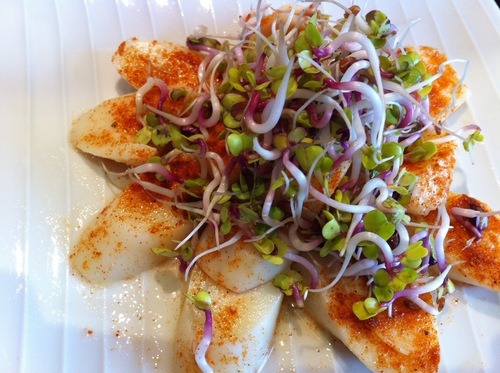A month on the 5:2 veggie diet

Team lovefood has already tried the increasingly popular 5:2 diet, without much success. But would it make a difference if we cut out the meat? Here’s how Charlotte got on with the 5:2 vegetarian diet.
5:2 vegetarian
 My desk is piled high with recently published cookery books, and, because there are so many, it takes a special title to grab my attention. Celia Brooks’ 5:2 Vegetarian arrived early in the New Year, just as I was formulating a plan to try and shed the extra Christmas weight I’d put on. Never having heard of a vegetarian version of the 5:2 diet, I was intrigued and decided to give it a go for a month. Besides, I don’t eat much meat anyway – how hard could it be?
My desk is piled high with recently published cookery books, and, because there are so many, it takes a special title to grab my attention. Celia Brooks’ 5:2 Vegetarian arrived early in the New Year, just as I was formulating a plan to try and shed the extra Christmas weight I’d put on. Never having heard of a vegetarian version of the 5:2 diet, I was intrigued and decided to give it a go for a month. Besides, I don’t eat much meat anyway – how hard could it be?
The fundamentals of the 5:2 vegetarian diet are essentially the same as the meat version – for two days of the week, you must restrict your diet to 500 calories a day (or 600 for men), while eating normally for the remaining five days. Lovefood’s Simon tried the original 5:2 diet in January last year, losing only four pounds (1.8kg) over a tortuous month-long period. Although, as Simon admitted, that could have been because he over-compensated during the five normal eating days.
Celia Brooks, a vegetarian herself, has had eight cookbooks published worldwide and spends much of her time leading ‘Gastrotours’ around London’s best culinary hotspots. Her new book, 5:2 Vegetarian, is a collection of over 100 easy fasting diet recipes, all of which promise to be delicious. Indeed, Celia follows the 5:2 diet religiously and uses her own recipes every week – a fact I found comforting, because no foodie could bear to eat dull food, even if it is only for two days of the week.
A Mars bar and a packet of crisps
 First things first: 500 calories is really very little. It’s one Mars bar plus a packet of cheese and onion McCoys, for example, or 10 apples. Just my normal breakfast – a croissant and a glass of orange juice – would exceed a day’s limit, so I knew I was in for a tough time. Before I began my diet, I asked Celia (pictured left) for some top tips to stay on track.
First things first: 500 calories is really very little. It’s one Mars bar plus a packet of cheese and onion McCoys, for example, or 10 apples. Just my normal breakfast – a croissant and a glass of orange juice – would exceed a day’s limit, so I knew I was in for a tough time. Before I began my diet, I asked Celia (pictured left) for some top tips to stay on track.
“I’d suggest avoiding Fridays and weekends when it comes to fast days, because there might be social opportunities where you want a drink or two! I usually go for Monday and Wednesday or Thursday. But whatever works for you," she said.
“Also, try drinking herbal tea on fast days. Liquorice tea is especially good and tastes a bit sweet even without added sweetener. It’s also meant to be an appetite suppressant. Remember, it’s 24 calories for 50ml semi-skimmed milk in your calorie-free tea… but if I really need caffeine I'll do a double scoop of instant espresso with a dash of milk.”
Sound advice, but there’s no way I was going to give up caffeine for a whole week – I tried that when I ‘lived below the line’ last year, and it was a headache-filled nightmare. Black tea it was then.
Planning the day's meals
 Throughout my 5:2 vegetarian challenge, I used Celia’s book for most of my breakfast, lunch and dinner recipes. There were times when I just didn’t have the minutes to cook, and in those instances I bought the lowest calorie packaged sandwich possible at lunch time – not the most enjoyable experience. My first fast day comprised Celia’s apple cinnamon porridge (143 calories) for breakfast; a 184 calorie portion of micro-broccoli salad with sweet seed clusters and egg for lunch (delicious, actually, although I could have eaten twice as much); and a spicy Egyptian bean soup (127 calories) for dinner. That’s a total of 454 calories, leaving just 46 calories spare for a stick of carrot or two.
Throughout my 5:2 vegetarian challenge, I used Celia’s book for most of my breakfast, lunch and dinner recipes. There were times when I just didn’t have the minutes to cook, and in those instances I bought the lowest calorie packaged sandwich possible at lunch time – not the most enjoyable experience. My first fast day comprised Celia’s apple cinnamon porridge (143 calories) for breakfast; a 184 calorie portion of micro-broccoli salad with sweet seed clusters and egg for lunch (delicious, actually, although I could have eaten twice as much); and a spicy Egyptian bean soup (127 calories) for dinner. That’s a total of 454 calories, leaving just 46 calories spare for a stick of carrot or two.
Even after just a week into the diet (so two fast days), I was really missing my homemade bread toasted in the mornings. So Celia’s recipe analyst Anita Bean kindly worked out how many calories are in a slice of my own bread: 124, to be precise. As a result, I started giving up small portions of porridge and mashed eggs for a single slice of toast with a scraping of margarine, and a very little dash of honey in the mornings.
 It wasn’t all bad – I genuinely enjoyed most of Celia’s recipes. Especially her miso noodle bowl (pictured, and 102 calories); spicy palm heart salad (pictured further up, and 129 calories); mango and black bean salad (175 calories); courgette frittata (175 calories); sweet & sour tofu pineapple (142 calories); garlic mushrooms (40 calories for a small handful); caramelised artichokes (62 calories) in an omelette; and, my personal favourite, Pappa al Pomodoro (75 calories), which is made from canned cherry tomatoes, balsamic vinegar, a bit of veg stock, garlic, honey, basil and sourdough bread.
It wasn’t all bad – I genuinely enjoyed most of Celia’s recipes. Especially her miso noodle bowl (pictured, and 102 calories); spicy palm heart salad (pictured further up, and 129 calories); mango and black bean salad (175 calories); courgette frittata (175 calories); sweet & sour tofu pineapple (142 calories); garlic mushrooms (40 calories for a small handful); caramelised artichokes (62 calories) in an omelette; and, my personal favourite, Pappa al Pomodoro (75 calories), which is made from canned cherry tomatoes, balsamic vinegar, a bit of veg stock, garlic, honey, basil and sourdough bread.
That empty feeling
But despite not missing out on flavoursome food, I did mourn the loss of feeling full. No matter how many vegetable crudités I ate, or liquorice herbal teas I drank, I never felt satisfied on fasting days. My stomach growled throughout the day, and I think fasting is harder when you have to commute in and out of a big city every day. If I worked from home, I think I could have managed 5:2 a little better. But an hour-long journey into London, including much fast-paced walking, does take it out of you, and for me a 100-odd calorie breakfast wasn’t enough to keep me going. And when I was on my way home, the fact that I couldn’t look forward to a big pile of spaghetti, or some sausage and mash, made me feel quite sad.
So ashamedly, I only managed three weeks on the diet, so six fasting days in all. Like I say, the key problem for me was quantity of food – I’m too much of a glutton to be content with fist-size portions. Having said that, I did lose nearly six pounds in total, which isn’t bad for just six days of dieting.
And remember, you can eat pretty much whatever you want during the other five days… as long as it’s in moderation. But there aren’t many diets which allow you to indulge in delights such as cheese, cake and wine for most of the week!
All in all, 5:2 works. And seeing as I lost an extra couple of pounds when compared to Simon (who did it for a whole month), perhaps cutting out meat does make a difference?
Have you tried the 5:2 diet? Was it the meat or vegetarian version? Did it work? Talk to us in the Comments box below.
You might also like
Comments
Do you want to comment on this article? You need to be signed in for this feature